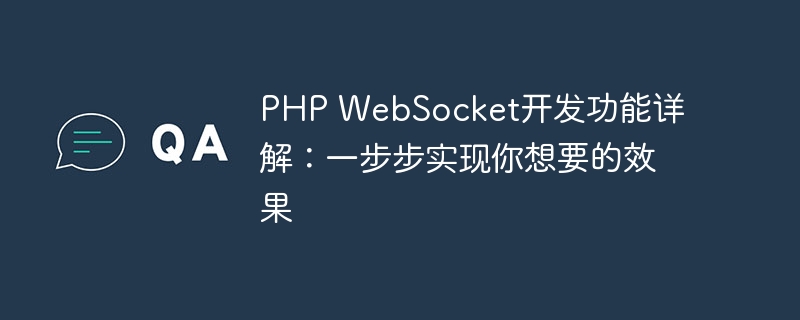Home >Backend Development >PHP Tutorial >Detailed explanation of PHP WebSocket development functions: step by step to achieve the effect you want
Detailed explanation of PHP WebSocket development functions: step by step to achieve the effect you want
- WBOYWBOYWBOYWBOYWBOYWBOYWBOYWBOYWBOYWBOYWBOYWBOYWBOriginal
- 2023-09-11 12:39:271117browse

PHP WebSocket is a very powerful technology that makes real-time communication possible. This article will introduce in detail how to use PHP WebSocket to develop various functions and achieve the results you want step by step.
WebSocket is a protocol that establishes a persistent connection between a client and a server, allowing two-way communication and the ability to transmit data in real time. Compared with traditional HTTP requests, WebSocket can save bandwidth and server resources, and can push data to the client in real time, which is very suitable for application scenarios such as real-time communication, chat rooms, and instant updates.
First, we need to create a WebSocket server. In PHP, you can use third-party extensions such as Ratchet or Swoole to easily create WebSocket services. Both extensions provide highly extensible interfaces that make WebSocket implementation very simple.
Next, let’s implement a simple chat room function. First, we need to create a WebSocket server and listen for user connections. When a user connects to the server, we need to save the connected user information. We can use an array to save each connected client.
Generally speaking, a chat room needs to implement two functions: sending messages and receiving messages. Sending messages can be implemented through JavaScript code on the client side. We can use the send method of the WebSocket object to send the message to the server. Receiving messages requires listening for client messages in the WebSocket server and broadcasting the received messages to all connected clients.
In the WebSocket server, we can use the onMessage event to listen for messages sent by the client. When a message is received, we can loop through each saved connection and send the message to each connected client. In this way, the broadcast function of the message can be realized.
In addition to chat rooms, we can also implement other functions such as online games and real-time notifications. For example, in a real-time blogging application, we can push new articles to all online users in real time. In the server, we can write a function to push new articles and call the function when a new article is received. The function can be implemented by looping through each saved connection and sending new articles to each connected client using the send method of the WebSocket object.
In addition, we can also use other features of WebSocket to enhance the user experience. For example, we can implement the heartbeat detection function, regularly send heartbeat messages to the client, and monitor the heartbeat messages through the client's JavaScript code. If the heartbeat messages stop receiving, it means that the connection is disconnected, and the corresponding processing logic can be triggered.
To summarize, PHP WebSocket is a very powerful technology that can be used to implement various real-time communication functions. This article helps readers understand and use PHP WebSocket by introducing how to create a WebSocket server and implement a simple chat room function. By studying this article, readers can achieve the effects they want step by step, and can expand more functions according to their own needs. I hope this article will be helpful to everyone’s learning and development.
The above is the detailed content of Detailed explanation of PHP WebSocket development functions: step by step to achieve the effect you want. For more information, please follow other related articles on the PHP Chinese website!

